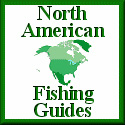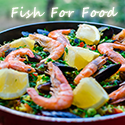Bass on Hook is Supported by our readers. As an Amazon Associate We earn commissions from qualifying purchases. For more informtion read our Amazon Affiliate Disclosure and Affiliate Disclosure Policies.
Fish Cooking Techniques
On this page you'll find many cooking methods and guidelines.
Also you'll find some basic and not so basic brines, marinades, sauces, stuffing, etc.
Excellent Quality Brand Name Cooking Appliances For Fish and More!
4 Great Appliances to cook your catch all with outstanding reviews.
Click Products Below To Learn More (Affiliate Links)
Cooking Guidelines and Methods for Fish
Fish are naturally tender and contain very little connective tissue. Unlike meat, they require short cooking times at a high temperature.
Guidelines for Cooking Fish
Measure fish (dressed or stuffed, fillets or steaks) at thickest part.
Allow 5-7 minutes cooking time per cm of thickness (10 minutes per inch) for fresh fish.
Allow 10-12 minutes cooking time per cm of thickness (20 minutes per inch) for frozen fish.
Fish is ready when fish is opaque and flakes easily.
DO NOT OVERCOOK
Dry Heat Cooking Methods
Air Dryer Cooking
Cooking fish and seafood with an air dryer is a unique and innovative method that offers several advantages. An air dryer, or food dehydrator, uses low heat and constant airflow to gently cook and dehydrate food. When applied to fish and seafood, this technique yields delicious and distinct results.
Using an air dryer for fish and seafood offers a healthier alternative to traditional cooking methods. The low-temperature drying process helps retain the natural flavors, nutrients and textures of the ingredients. By avoiding excessive oil or fats, this method promotes a lighter and more nutritious dish.
The air dryer allows for precise control over the cooking time, resulting in consistent and evenly cooked fish and seafood. This eliminates overcooking or undercooking your dish. Thereby ensuring a perfectly cooked and tender outcome.
The gentle drying process also enhances the natural umami flavors and concentrates the taste of the fish and seafood. This method is effective with delicate and oily fish varieties, as it helps reduce excess moisture, resulting in a firmer texture and intensified flavors.
Using an air dryer for fish and seafood offers versatility in flavoring. Marinating the fish or seasoning seafood before the drying process allows the flavors to infuse deeply into the ingredients. This results in a rich and well seasoned final product.
Cooking fish and seafood with an air dryer opens up new culinary possibilities, providing a healthier, flavorful and convenient approach to preparing these delectable ingredients.
Baking
Baking is the process of cooking fish at certain temperatures in an oven.
Place fish in a greased baking pan.
Brush with melted butter and season with salt and pepper.
Bake in center of preheated oven at 230° celsius (450° fahrenheit).
Follow cooking guidelines above.
-Use fresh or thawed fish
-Flavor with basting sauce, lemon juice or dry white wine
-Stuff dressed fish no more than ⅔ full
-Serve as is or with a sauce
Barbecuing
Barbecuing is the process of cooking fish at high temperatures over coals or an open flame.
Marinate fish.
Place in oiled wire basket on oiled grill.
Baste with marinade during cooking.
Cook 7-10 cm (3-4 inches) above coals or flame, turning halfway through cooking time.
Follow cooking guidelines above.
-Use fresh or thawed fish
-Place charcoal/propane barbecue in a well ventilated location.
Adjust air trap.
-Try this method for kababs or for foil-wrapped fish with vegetables.
Excellent Quality Brand Name Cast Iron Grill Plates and Stainless Steel Deep Fryers For Fish and More!
4 Great cast iron grill plates and stainless steel deep fryers to cook your catch all with outstanding reviews.
Click Products Below To Learn More (Affiliate Links)
Blackening
Blackening is the process of cooking fish by coating in spice and cooking at extremely high heat.
The process actually creates a barrier between the food and the heat, allowing blackening, not burning, to occur.
To blacken properly, a cast iron skillet or grill plate is heated over very high temperature until just short of a white spot or ash appearing (The skillet or grill must be extremely dry before it is heated).
The fish to be grilled should be at room temperature.
Dip fish into melted, clarified butter, then sprinkle with spice (notes: for more flavor, roll fish into spice mix before cooking and the butter can be omitted to reduce calories).
Place the fish onto the pan, cooking for 1-2 minutes on each side.
Blackening adds a distinctive flavor to fish while creating a savoury, moisture-retaining barrier around the outside.
The result? Warm, smoky grilled flavors and succulent textures.
The high heat required by blackening means that you will need a skillet or pan made of cast iron.
There is really no substitute.
Also, blackening will create smoke (and how!).
Work in a well-ventilated area - outdoors using a gas grill will work, as will a commercial kitchen environment.
Broiling
Broiling is the process of cooking fish under an open flame or electric element at high temperatures.
Brush fish with melted butter and season OR marinate.
Place in single layer on a well greased broiler pan.
Broil 7-10 cm (3-4 inches) from the preheated unit.
Baste during cooking.
Follow cooking guidelines above.
-Use fresh or thawed fish
-Turn thick pieces halfway through cooking time
-Serve as is or with a sauce
Bronzing
Bronzing is a name that we apply to a technique similar to "blackening", but at a lower temperature than is required for blackening.
As with blackening, bronzing is cooking fish by coating the fish in spice and cooking it quickly on a pan or grill.
Bronzing spices generally contain more herbs than blackening spices.
The spice and the cooking process create a crispy, flavorful barrier around the fish being bronzed.
To "bronze" properly, a stainless steel pan is heated over high temperature (The skillet or grill should be dry before it is heated).
The food to be grilled should be at room temperature.
Sprinkle the food with bronzing spice (notes: for more flavour, roll food into spice mix before cooking).
Place the food onto the pan, drizzle with a small amount of melted, clarified butter.
Cook for 1-2 minutes.
Turn with a spatula and drizzle again with a small amount of butter.
Cook for another 1-2 minutes and remove from the pan.
Bronzing adds a distinctive flavour to fish while creating a savoury, moisture retaining barrier around the outside.
By creating a crisp, savoury coating of spice, the full flavour of the fish being bronzed develops inside - creating a delicious balance between the discrete combinations of flavour and texture.
The heat required by bronzing means that you will need a good quality stainless steel pan which won't warp when heated.
A slim stainless or Teflon spatula is also helpful to remove the food from the pan without tearing the outer, spiced layer of the food away.
Microwave Baking
Microwave baking is the process of cooking fish using microwaves that generate heat internally instead of externally.
Therefore only the fish becomes hot.
Any heat noticed inside the oven or from the baking dishes comes from the fish as it becomes hot.
Thus time, not temperature and heat, is the variable in microwave cooking.
Melt butter at High Power.
Mix with chopped parsley, green onion and lemon juice.
Remove half of mixture and reserve.
Arrange 500 gm of fish in dish; season to taste.
Top with remaining mixture.
Cover; microwave at High Power 6-8 minutes, rotating dish during cooking.
Let stand covered for 2 minutes.
-Use fresh or thawed fish
See our page on microwaving food.
Moist Heat Cooking Methods
Canning Fish And Seafood
Canning fish and seafood is an excellent method for preserving their freshness and flavors. Canning allows you to enjoy these delicacies long after their catch.
Follow these basic steps to safely and effectively can fish and seafood:
- Begin with fresh and high quality fish or seafood. Ensure they are properly cleaned, removing scales, guts and any other unwanted parts.
- Prepare canning jars by thoroughly washing and sterilizing them. This can be done by boiling the jars or using a dishwasher with a sterilization cycle.
- Pack the fish or seafood tightly into the jars, leaving appropriate headspace as recommended (Usually 1 inch (2.5 centimeters)) in canning guidelines. Add any desired seasonings or brine to enhance flavors.
- Pour hot water, fish stock or brine over the fish, ensuring all ingredients are fully covered. Leave the recommended headspace.
- Carefully remove any air bubbles by gently tapping the jars or using a non metallic utensil.
- Wipe the jar rims clean and securely apply the lids and bands, ensuring they are properly tightened.
- Place the jars in a pressure canner or boiling water bath canner. Follow the recommended processing time (avg:75 to 120 minutes) and pressure (avg:11 pounds per square inch (psi) for a dial gauge canner or 10 psi for a weighted gauge canner) for the specific type of fish or seafood. This step is crucial for safely preserving the contents.
- After processing, carefully remove the jars from the canner and let them cool undisturbed. Check for proper sealing by ensuring the lids are concave and do not flex when pressed.
- Label the jars with the contents and date to keep track of their freshness.
Keep canned fish and seafood in a cool, dark place for extended storage. They are ready to be enjoyed in various recipes or as a standalone delicacy.
Oven Steaming
Oven steaming is the process of cooking fish wrapped in aluminum foil in an oven with a cooking liquid or sauce.
Place on greased heavy-duty aluminum foil.
Season, flavor with lemon juice, butter and parsley.
Wrap tightly.
Place on cookie sheet.
Bake in center of preheated oven at 230° celsius (450° fahrenheit).
Follow cooking guidelines above.
-Use fresh or frozen fish
-Flavor with wine, herbs, juice or vegetables
-Use cooking liquid for sauce
Poaching in Court-Bouillon
Poaching is the process of cooking fish in boiling water.
Prepare a court-bouillon.
Wrap fish in cheese cloth.
Place in rapidly boiling liquid, cover pan, return to boil, then reduce to simmer.
Follow cooking guidelines above.
-Use fresh or frozen fish
-Drain court-bouillon for reuse, refrigerate for up to 1 week or keep frozen for up to 2 months
Poaching in Water or Milk
Cook fish directly in salted boiling water OR wrap tightly in greased heavy-duty aluminum foil with chopped onion, celery, salt and pepper; place in rapidly boiling water.
Cover pan, return to boil, then reduce heat to simmer.
To poach smoked fillets, cover with cold milk flavored with butter, bay leaf, pepper; simmer.
Follow cooking guidelines above.
-Use fresh or frozen fish
-Use 2ml of salt per L of water (¼ tsp per quart) for fish
-Use poaching liquid for white, cheese or egg sauce
Pressure Cooking Fish And Seafood
Cooking fish and seafood with a pressure cooker is a convenient and efficient method that yields delicious and tender results. A pressure cooker utilizes high pressure steam to cook food quickly, locking in flavors and retaining moisture.
When cooking fish and seafood in a pressure cooker, the enclosed environment allows for faster cooking times compared to traditional methods. This not only saves time but also preserves the delicate texture and flavors of the ingredients.
The high pressure steam infuses the fish and seafood, resulting in succulent and moist dishes. The intense heat and pressure help break down tough fibers, making the seafood tender and easy to bite.
Cooking fish and seafood in a pressure cooker enhances the absorption of flavors. By adding aromatic herbs, spices or marinades to the cooking liquid, the ingredients absorb these flavors more intensely. The end result is a more flavorful and aromatic final dish.
The controlled pressure and temperature in a pressure cooker prevent the loss of natural juices. Thereby ensuring that the fish and seafood remain moist and flavorful. This method is particularly useful for cooking delicate fish varieties that are prone to drying out during conventional cooking methods.
The pressure cooker's versatility allows for various cooking techniques such as steaming, poaching or even creating flavorful seafood stocks or broths.
Pressure cooking fish and seafood creates convenient, flavorful dishes. All this with minimal effort and maximum results.
Excellent Quality Brand Name BPA Free Steamers For Fish and More!
4 great steamers to cook your catch all with outstanding reviews.
Click Products Below To Learn More (Affiliate Links)
Frying Cooking Methods
Pan-Frying
Frying is the process of cooking fish in an open pan or pot using butter, lard or oil.
Season each portion of fish.
Cover lightly with flour.
Dip in liquid (milk or beaten egg).
Coat with flour or crumbs.
Heat butter or cooking fat.
Fry on both sides.
Follow cooking guidelines above.
Drain on absorbent paper.
-Use fresh or thawed fish
-Try this method for fish cakes or small fish such as smelt and rainbow trout
Deep Frying
Preheat oil to 190° celsius (375° fahrenheit).
Sprinkle fish with salt.
Coat with batter OR cover lightly with flour, dip in milk or beaten egg, then coat with flour or crumbs.
Fry a few pieces at a time.
Follow cooking guidelines above.
Drain on absorbent paper.
-Use fresh or thawed fish
-Be sure the fat returns to 190° celsius (375° fahrenheit) before frying additional pieces
-Serve with lemon wedges or sauce
Cooking Basics
Brine Solutions for Freezing
- 1 liter cold water (4 cups)
- 50 ml (3 Tbsp) pickling salt. OR 1 liter cold water (4 cups)
- 40 ml (2.5 Tbsp) pickling salt
Stir well to dissolve salt.
Use as directed for freezing fish
Court-Bouillon for Poaching
- 125 ml (½ cup) vinegar or dry white wine.
- 15 ml (1 Tbsp) salt
- 1 celery stalk
- 50 ml (¼ cup) sliced onion
- 50 ml (¼ cup) sliced carrot
- 1 ml (¼ tsp) thyme
- 2 ml (½ tsp) peppercorn
- 1 Bay leaf
- 15 ml (1 Tbsp) chopped parsley
- 1 L (4 cups) boiling water
Combine all ingredients and pour over fish fillets.
Cover and boil gently 10 minutes.
Use to poach fish.
Strain, then use as a base for soups and sauces or freeze for reuse in poaching.
Makes about 1 liter (4 cups).
Crispy Batter for Deep-Frying
- 250 ml (1 cup) all-purpose flour
- 10 ml (2 tsp) baking powder
- 6 ml (1.25 tsp) salt
- 10 ml (2 tsp) sugar
- 15 ml (1 Tbsp) vegetable oil
- 250 ml (1 cup) water
Mix and sift dry ingredients.
Add oil to water.
Make a well in the dry ingredients and slowly pour in liquid, stirring until well-blended.
Makes enough for 1 kg. (2.2 pounds) fish.
Marinades
Fish Marinade
- 2 cups white wine
- 2 tablespoons lemon juice
- 2 teaspoons salt
- tablespoons prepared brown mustard
- 2 teaspoons salt
- ½ teaspoon cayenne pepper
In a bowl combine white wine, lemon juice, salt, prepared brown mustard, salt and cayenne pepper.
Marinade the fish 6-12 hours.
Use the marinade as a basting sauce while cooking.
Serving Size: 6
Basic Sauces
Chilled Sauces for Fish
Cocktail Sauce:
- 125 ml (½ cup) chili sauce
- 100 ml (⅓ cup) ketchup
- 100 ml (⅓ cup) prepared horseradish
- 7 ml (1.5 tsp) Worcestershire sauce
Mix.
Serve well-chilled.
Flavored Mayonnaise:
Add color and flavor with herbs, tomato paste, saffron, turmeric or curry powder.
Season with garlic, ginger, shallots, lemon juice and/or cream.
Tartar Sauce:
- 250 ml (1 cup) mayonnaise
- 15 ml (1 Tbsp) green relish
- 15 ml (1 Tbsp) chopped parsley
Mix.
Serve well-chilled.
Cooked Sauces for Fish
Cheese Sauce:
Make a medium white sauce with milk and/or fish stock.
Add grated cheese, stir until melted.
Chinesey Fish Sauce:
- 30 ml (2 Tbsp) flour
- 75 ml (5 Tbsp) granulated sugar
- 5 ml (1 tsp) ginger
- 150 ml (½ cup) water
- 75 ml (5 Tbsp) white vinegar
- 75 ml (5 Tbsp) soy sauce
- 30 ml (2 Tbsp) chopped green onion
Mix flour, sugar and ginger.
Add to water, vinegar and soy sauce in saucepan.
Cook slowly, stirring constantly, until thick.
Serve over hot cooked fish; top portions with chopped green onion.
Lemon Chive Sauce:
- 50 ml (3 Tbsp) butter
- 15 ml (1 Tbsp) chopped chives
- 10 ml (2 tsp) lemon juice
- 2 ml (½ tsp) grated lemon rind
Heat through.
Season with salt and pepper to taste.
Lemon Dill Sauce for Fish
- 2 teaspoons yogurt
- 1 teaspoon cornstarch
- ¼ teaspoon dillweed
- ⅛ teaspoon pepper
- 2 tablespoons lemon juice
In a large bowl, blend together yogurt with cornstarch, dillweed and pepper until smooth.
To cook with fish: Brush lemon juice over the fish and broil until almost cooked.
Turn the fish and brush evenly with the yogurt/dill sauce.
Continue broiling until fish flakes easily.
Serving Size: 4
Tomato Sauce:
- 25 ml (2 Tbsp) chopped onion
- 25 ml (1 Tbsp) butter
- 25 ml (1 Tbsp) flour
- 5 ml (1 tsp) sugar
- 500 ml (19 oz) canned tomatoes, chopped
- 1 Bay leaf
Saute onion in butter.
Thicken with flour.
Add sugar, tomato and bay leaf.
Cook until thick.
Season with salt and pepper to taste.
Stuffing
Bread Fish Stuffing:
- 60 ml (4 Tbsp) chopped onion
- 75 ml (5 Tbsp) chopped celery
- 75 ml (5 Tbsp) chopped green pepper
- 60 ml (4 Tbsp) butter or margarine
- 725 ml (2 ¾ cup) soft bread crumbs
- 5 ml (1 tsp) salt-f.g. white pepper
- 1 ml (¼ tsp) thyme leaves
- 1 ml (¼ tsp) savoury
Cook onion, celery and green pepper in butter or margarine for 8 to 12 minutes until onion is transparent.
Add to bread crumbs with seasonings; toss lightly.
Makes enough to stuff a 1.5-2 kg (2-5 pound) dressed fish.
Lemon Rice Fish Stuffing:
- 75 ml (5 Tbsp) butter or margarine
- 250 ml (1 cup) sliced celery
- 50 ml (3 Tbsp) chopped onion
- 250 ml (1 cup) sliced fresh mushrooms
- 1 ml (¼ tsp) poultry seasoning
- 8 ml (1 ¾ tsp) salt
- 3 ml (¾ tsp) white pepper
- 10 ml (2 tsp) grated lemon rind
- 15 ml (1 Tbsp) chopped parsley
- 60 ml (4 Tbsp) lemon juice
- 325 ml (1 ¼ cup) water
- 425 ml (1 ¾ cup) Long Grain White Minute Rice (Affiliate Link)
Melt butter or margarine in fry pan.
Add celery, onion and mushrooms; cook for 8 tp 12 minutes until onion is transparent.
Add seasonings, lemon rind, parsley, lemon juice and water; bring to boil.
Add rice; cover remove from heat; let stand 5 minutes.
Makes enough to stuff and serve a 4 kg (9 pound) fish.






















